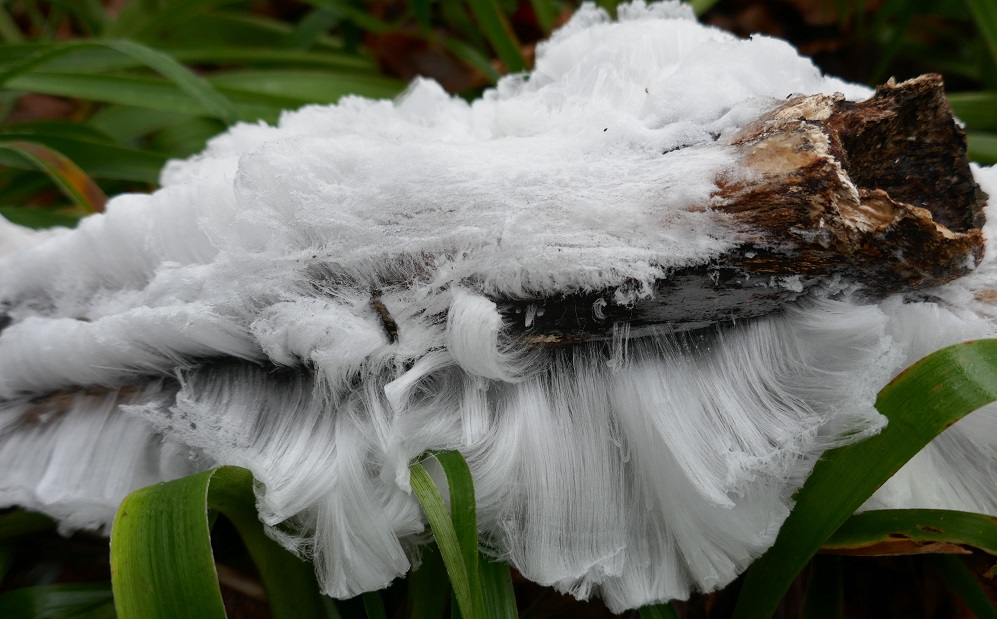
The days are noticeably longer and the rooks are squabbling over nesting positions in the local rookery. Great skeins of geese darken the skies as the greylags head north again. The sky looks like a notice board of messages etched in wingbeats as wave after wave of birds flies in formation. Sometimes a single line passes overhead looking like sutures holding the sky together and the noise is deafening.
I’ve walked 87 miles this month with still a few more days to go, and with a new pair of boot on order. The highlight was a walk in Cawdor Woods today with my beekeeping friend Jane when we discovered branches covered in hair ice. This is new to me, but Jane has seen it where she lives just a few miles further uphill from my home. I’m amazed at this new sight.
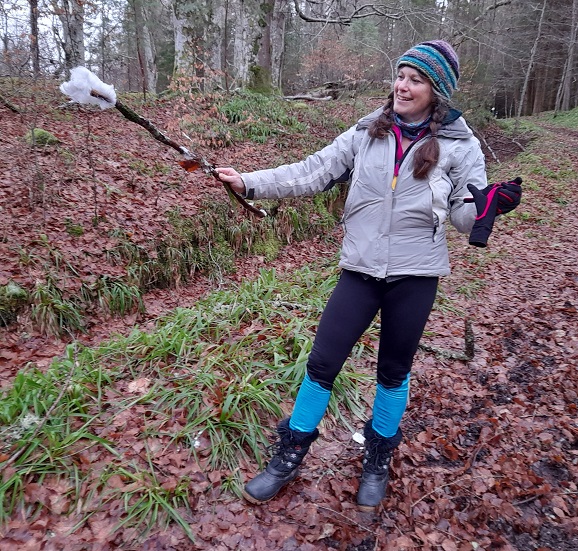
A Fungus.
Did you know that a fungus called Exidiopsis effusa living in old rotten moist wood causes this impressive candy floss effect in winter when the temperature is just below freezing? It also needs a broadleaf forest and humid conditions. The fungi allow thin hairs of ice to form and be pushed out of the wood. These fine hairs have a diameter of 0.01mm and look just like a wig in the top photo.
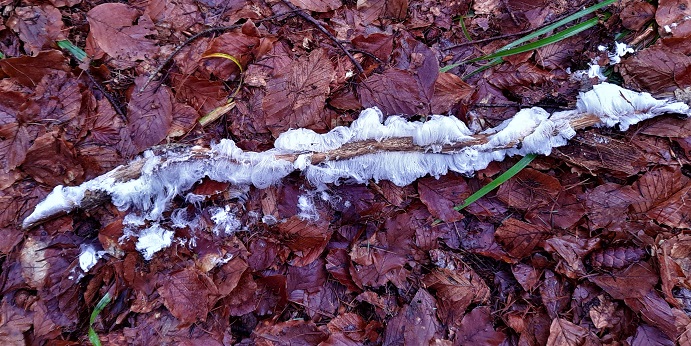
January Plants.
It’s interesting to watch the plants wake up and start flowering. Some, like laurel sporting only a spike or two of flowers here and there, and others like red dead- nettle meaning business and out in full flower. Here’s the list:
6th Prunus subhirtella: Roseaceae family
Viburnun bodnantense: Caprifoliaceae family
Hedera helix, ivy: Araliaceae family
7th Galanthus nivalis, snowdrop: Amaryllidaceae family
Coronilla glauca, scorpion vetch: Fabaceae family
Mahonia spp: Berberidaceae family
Jasminium nudiflorum, winter jasmine: Fabaceae family
Ulex europaeus, whins/gorse: Fabaceae family
10th Primula spp: Primulaceae family
Viola spp. hybrid pansies in garden: Violaceae family
17th Prunus laurocerasus, cherry laurel: Lauraceae family
Sarococca spp. sweet box: Buxaceae family
19th, Vinca major, greater periwinkle: Menyanthaceae, (bogbean family)
21st, Hellebore niger, Christmas rose: Ranunculaceae family
22nd Eranthis hyemalis, winter aconite: Ranunculaceae family
26th Chaenomeles speciosa, Japanese quince: Roseaceae family
Lamium purpureum, red-deadnettle: Lamiaceae family
Hive Autopsy.
Every beekeeper is upset at losing a colony over winter but new beekeepers take it very hard and are often riddled with guilt. This last year has been exceptional with much reduced opportunities for the inexperienced to get practical hands on help and support from mentors. Studies from Europe (Jacques et al PLOS ONE | DOI:10.1371/journal.pone.0172591 March 9, 2017) confirm that over winter losses are higher for new inexperienced hobby beekeepers than for professional and experienced beekeepers. In fact, new beekeepers lose double the number of colonies which is a good reason for all countries to improve beekeeping education.
I’m about to put on my lab coat and disposable gloves and examine some frames and dead bees brought by a new beekeeper yesterday. I’ve got the stereo microscope set up but will probably not learn much from the bees which have been dead too long to dissect.
The History.
I’ve taken a history so I already have some idea as to what may have happened. The beekeeper had only one colony which swarmed, quite late for us here in Scotland, in late July. This means that there was a break in brood rearing just at the time when winter bees should have been produced to keep the colony going over winter. The new queen would not have been mated and laying eggs for at least 3 weeks which brings us to the last week in August. The beekeeper inspected the colony in early September. Upon finding the new queen the beekeeper caught her in a cage and marked her. From my own experience with losing queens this way, I only mark queens in spring when they cannot kill them off and produce another because there are no drones flying then. Sometimes marking queens causes the colony to supersede that queen.
The colony seemed, to the beekeeper, to be full of bees, and they were fed syrup to build up their winter stores. 3 weeks ago, at the end of December the beekeeper used oxalic acid trickle treatment for varroa and the colony was alive then. The weather has been cold and stormy recently and the brood box moved off square with the floor creating a small gap. Strapping securely all hives is good practice wherever you are. This week, the colony was found to be dead.
The beekeeper noted that the hive odour smelled normal with no obvious signs of disease present. The queen was not seen but it is possible that the marked queen had been killed by the bees after marking, and any new queen produced after then may not have been mated/mated well enough. There were no signs of brood on any of the frames.
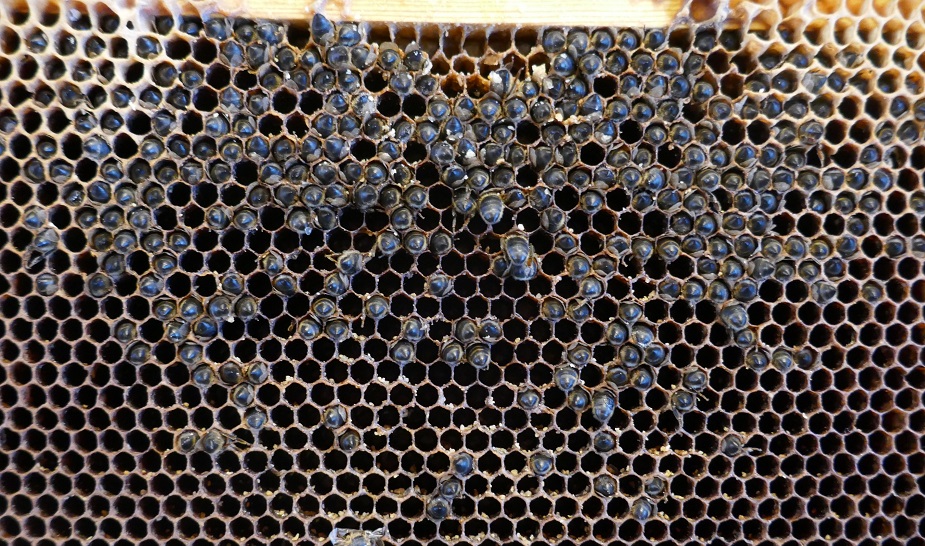
Isolation Starvation.
On comb inspection, there are no stores on any of the 3 frames. The combs are fairly new and clean with no sign of any disease. The bees have died with their heads in the cells searching for stores. The colony had reserve fondant on top, but the numbers of bees were too few to generate the heat required to move from the cluster to access stores in another part of the hive.
I checked a sample of 30 bees which gives a 95% chance of finding a 10% infection in a colony. The number is actually 28 bees but we always round it up to 30. I removed the heads of these bees which were becoming desiccated but I found no tracheal mites. I ground down the abdomens adding some drops of water and placing a drop of the smelly soup on a slide to check for nosema x400 magnification under my compound microcscope. I found none.
Advice to Beekeeper.
My advice to the beekeeper based on these finding is:
Keep more than one colony and unite such a colony with another before winter.
Learn about, and practice swarm management. If swarm control measures had been taken and the colony divided, rather than having the swarm lost, the original queen and colony could have been reunited with the colony that had a poor/non queen mating.
Clip queen wings in spring.
Make sure that fondant is directly over the winter cluster.
Securely strap hives together before winter/ all year round.
This beekeeper is a fine example of someone trying hard to learn from new situations and find out what might have gone wrong by asking me to do a hive autopsy. The best learning is achieved through our own experiences and from the mistakes we make. Learning is about changing our behaviour based on new information.
I’ve learned so much from the many mistakes that I’ve made, such as causing a nucleus to be all but robbed out by feeding it syrup in the middle of the day!
New Readers.
Welcome to all the new readers of beelistener, and those from: Singapore, Algeria, Georgia, Kyrgyzstan, Denmark, Ukraine, Estonia, Belgium, Philippines, South Korea, Tunisia, Lebanon and Kuwait who join us and bring the number of different countries accessing the blog to 53.
Thank You.
Thank you to those of you who have donated towards the upkeep and maintenance of this website. You’ve probably noticed that the site has been made secure to reduce risks. I appreciate your support.
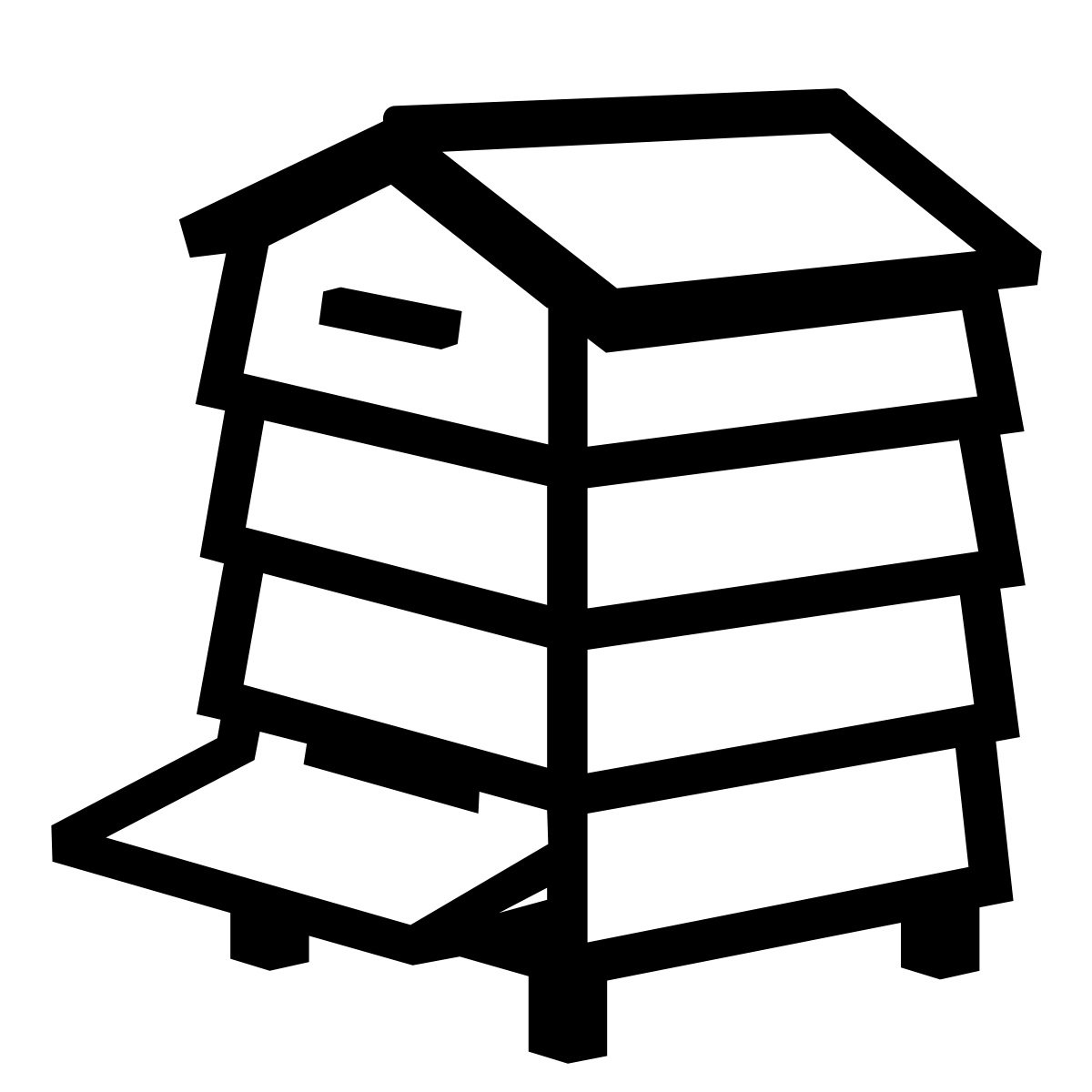
Very impressed with your hair frost. I’ve been looking for it in pine forests. Thank you for the explanation , I’ll now try deciduous ones.
A very interesting blog.
Hair frost sounds so much nicer, Cynthia. No chance of being mistaken for lice!!!
Dear Ann, I enjoy reading your blog and both the nature and beekeeping comments.
Re your autopsy of a hive. I have a query re feeding fondant. You say it was too far away for the small colony to go and get it. I keep national hives and have made sure the bees have plenty of food in the brood box and in a super. I’ve adopted the practise of putting on fondant in January, but am never quite sure where to put it. Do I take the super off and place it directly on the brood frames using an eke, or place it directly on the super frames using an eke, or place above the crown board? Currently I use the last method.
Dear Gavin, Thank you for your comments. If you have a super on with stores the bees will move up into the super when they finish supplies in the brood box (well they usually do). So, if you think that they need fondant I would take off the crown/cover board and place a queen excluder over the super (so that the fondant will not drip down on the bees if it absorbs water and becomes gloopy). You will see the winter cluster, if it has moved up into the super, and you can place the fondant (mostly still covered in plastic) on top of it. Best wishes for that and the coming season, Ann.
Take a few frames out the supers put piece of fondant covered in plastic in space put piece of newspaper between brood frames and fondant spike or score newspaper
Hello Hamish, thank you for contributing. Interesting alterative. What is the advantage of putting newspaper in place? If the cluster is not moving much due to cold weather, I’d want the easiest and quickest access for the bees which is why placing directly over the brood frames works well. If you have a super in place you can remove the middle frames and put in the fondant over the brood frames adding insulation to the space above.
Being busy with other things, I forgot how much I enjoy reading your blog, Ann! Bursting with interesting facts and written in attention catching style!
I saw hair frost last year in Evanton Woods. Time to go again to check if I can spot it now knowing more about it. Thank you 😊
Oh, thanks, Karolina. Quite a few readers are not beekeepers so I write for them too. With blogs and headings you can easily pick and choose what to read. Hair frost seems to vanish quickly when the temperature rises. Although yesterday was not warm, there were no traces of hair frost where Jane and I had been. After this cold night perhaps it has returned today so I shall go back and check.
We had the first busy apiary of the year which reminded me how much I miss it during the cold months.
Last year the hives seemed to be taking a lot of bees into the winter and their consumption of honey and syrup did not seem sustainable. So far so good in the apiary and the feral colonies but way too early to be sure.
I find it interesting to check the dead bees being brought out and any uncapped brood for signs of virus of infestation. Also interesting to note that the bees are much smaller now than later indicating the use of old brood comb at the centre of the colony during cold periods. I know that this would normally be rotated out but I am determined to do as they do in the wild and learn as many lessons as possible from them.
Interesting, Tristan. I wonder what Tom Seeley would say with regard to old comb in free-living colonies?
Let’s hope he’s reading
Hi Tristan and Ann, I don’t know how much the accumulation of pupal casings reduces the width of a cell over the years, but I can say that when I dissected the nests of 21 wild colonies, many of which were living on very dark combs, I found that the average wall-to-wall dimension for the cells in the broodnest combs of these wild colonies was 5.19 mm, thus slightly smaller than the 5.38 mm that I find in the broodnest combs of my managed colonies. The latter have drawn out standard comb foundation. Perhaps this difference was a result of long-term accumulations of pupal casings. As you probably know, when beekeepers (in the U.S., at least) talk about “small-cell comb,” they are referring to combs made of cells that are distinctly small, measuring only about 4.80 mm wall to wall.
Thanks for the information, I will measure up some of the comb when things warm up and some of the naturally drawn comb in a feral swarm that didn’t thrive last year
Thank you Ann. Both articles are very interstesting and insightful. x
That’s good, Maria. Thank you for commenting.